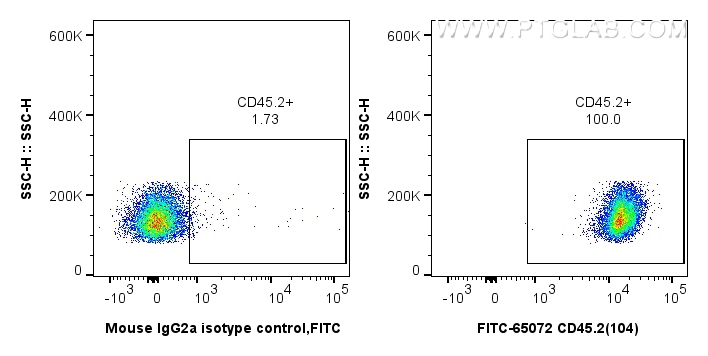验证数据展示
经过测试的应用
| Positive FC detected in | mouse splenocytes |
推荐稀释比
| 应用 | 推荐稀释比 |
|---|---|
| This reagent has been tested for flow cytometric analysis. It is recommended that this reagent should be titrated in each testing system to obtain optimal results. | |
| Sample-dependent, Check data in validation data gallery. | |
产品信息
FITC-65072 targets CD45.2 in FC applications and shows reactivity with mouse samples.
| 经测试应用 | FC Application Description |
| 经测试反应性 | mouse |
| 免疫原 | B10.S mouse thymocytes and splenocytes 种属同源性预测 |
| 宿主/亚型 | Mouse / IgG2a, kappa |
| 抗体类别 | Monoclonal |
| 产品类型 | Antibody |
| 全称 | protein tyrosine phosphatase, receptor type, C |
| 别名 | Cd45, Ptprc, Leukocyte common antigen, LCA, B220 |
| GenBank蛋白编号 | BC028512 |
| 基因名称 | CD45 |
| Gene ID (NCBI) | 19264 |
| RRID | AB_2883761 |
| 偶联类型 | FITC Plus Fluorescent Dye |
| 最大激发/发射波长 | 495 nm / 524 nm |
| 形式 | Liquid |
| 纯化方式 | Affinity purification |
| UNIPROT ID | P06800 |
| 储存缓冲液 | PBS with 0.09% sodium azide , pH 7.3 |
| 储存条件 | Store at 2-8°C. Avoid exposure to light. Stable for one year after shipment. |
背景介绍
CD45, also known as protein tyrosine phosphatase, receptor type C, is a type I transmembrane protein expressed on the surface of all haematopoietic cells with the exception of erythrocytes and platelets (PMID: 3489673; 28615666). CD45 is a pan-haematopoietic cell marker and has been shown to be essential for T- and B-cell activation and signalling (PMID: 9429890; 16378097). Allelic variants of mouse CD45, CD45.1 (Ly5.1) and CD45.2 (Ly5.1), have been established as a marker system to track haematopoietic cells following congenic mouse bone marrow transplants (PMID: 28615666). CD45.2 is the common form and is expressed by most of the established strains, while CD45.1 is found in only a few like the SJL mouse strain (PMID: 3489673).
实验方案
| Product Specific Protocols | |
|---|---|
| FC protocol for FITC Plus CD45.2 antibody FITC-65072 | Download protocol |
| Standard Protocols | |
|---|---|
| Click here to view our Standard Protocols |
